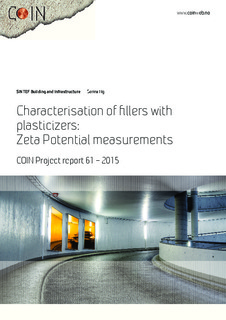| dc.description.abstract | The zeta potentials of five different fillers and three commercial plasticizers were explored in this report. The main purpose was to determine how these materials interact with each other to aid dispersions, in an effort to explain the macroscopic observations of sedimentations and interactions of fines in crushed aggregates with plasticizers. The investigation of the materials is divided into 2 areas and they will be summarized as below:
Area 1 – Understanding of sedimentation observation through zeta potential studies Three different sets of systems were explored: - cement alone, filler alone and cement/filler. In the cement system, regardless of plasticizers presence, the zeta potential was positive due to the high content of Al containing clinker phases in cement employed, and the ability to form double layer during surface adsorption by the cement particles. For fillers only system, the two fillers, limestone 2 and natural sand possessed differently charged surfaces, which were very close to isoelectric point. This indicated that they are relatively unstable and can flocculate easily. Upon adding to cement pore solution, stability of the system improved while a charge reversal was observed, attributing to the adsorption of ions from the pore solution onto the surfaces of the filler particle. There, it was found that the dispersing effectiveness by plasticizers can be a factor of both the stability of slurry (magnitude of zeta potential value) and the adsorbed amount of lignosulfonate as described by the change in zeta potentials.
Lastly, in the cement/filler combination system, the adsorption of plasticizers by fillers in presence of cement is dependent on the type of plasticizers present. MapaPlast is adsorbed rapidly by both fillers and cement due to its inherent high negative charge. In the case of SP-130, preferential adsorption appears to favour cement in the presence of limestone 2, whereas competitive adsorption is present when natural sand is mixed with cement. The large zeta potential value of pastes containing MapaPlast as compared to those with SP-130 indicated that the former system is more stable, whereby the tendency to undergo flocculation is lower. In general, adsorption of plasticizers by the particles – fillers or cement is a rapid process.
Area 2 – Understanding of the behaviour of SXN in three selected filler obtained from crushed aggregates Three different fillers; a limestone (different from that from Area 1), an anorthosite and a quartzite were investigated. One plasticizer, SXN was employed here. When the zeta potentials of the fillers were studied alone, all three fillers displayed very different zeta potentials when measured in the cement pore solution. Anorthosite registered a very positive zeta potential of +12.4mV, limestone 0.0mV and quartzite -3.4mV. These results indicate that limestone has the highest tendency flocculate when left alone, whereas anorthosite is the most stable.
When SXN was added, the interaction between the plasticizers and fillers differed. With anorthosite, rapid consumption which plateau at around 0.5%bwoc of SXN added. Limestone is a gradual process with preferential adsorption of polycarboxylate based polymers with shorter side chains, whereas quartzite is more unpredictable in terms of adsorption. However, it seems that quartzite prefer polymers with longer side chain. Stability of the systems is greatest for anorthosite system, but the degree of adsorption and dispersion cannot be purely measured by the zeta potential due to the steric effect of the long side chain from the polycarboxylate based polymers SXN, particularly in the case of quartzite. | |
